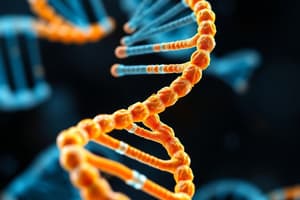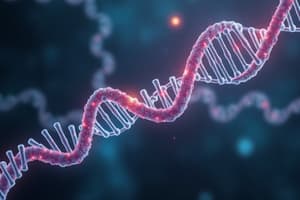Podcast
Questions and Answers
What is the role of RNA polymerase during transcription?
What is the role of RNA polymerase during transcription?
- It transports amino acids to the ribosome.
- It joins Okazaki fragments together.
- It synthesizes a complementary RNA strand from the DNA template. (correct)
- It facilitates the splicing of mRNA.
During which process are introns removed from the RNA molecule?
During which process are introns removed from the RNA molecule?
- Post-transcriptional modification (correct)
- Replication
- Translation
- Transcription
What is the primary function of the ribosome in translation?
What is the primary function of the ribosome in translation?
- To splice non-coding regions from mRNA.
- To transport tRNA molecules to the nucleus.
- To synthesize RNA from DNA.
- To read mRNA codons and link amino acids. (correct)
What signals the end of the translation process?
What signals the end of the translation process?
What distinguishes Okazaki fragments from the leading strand during DNA replication?
What distinguishes Okazaki fragments from the leading strand during DNA replication?
What is the primary function of helicase during DNA replication?
What is the primary function of helicase during DNA replication?
Why do Okazaki fragments form during DNA replication?
Why do Okazaki fragments form during DNA replication?
In DNA, which nitrogenous base pairs with adenine?
In DNA, which nitrogenous base pairs with adenine?
What component is present in RNA but not in DNA?
What component is present in RNA but not in DNA?
Which statement about the structure of DNA is incorrect?
Which statement about the structure of DNA is incorrect?
What is the result of semiconservative replication?
What is the result of semiconservative replication?
What replaces thymine in RNA?
What replaces thymine in RNA?
Which enzyme is responsible for creating a complementary DNA strand during replication?
Which enzyme is responsible for creating a complementary DNA strand during replication?
Flashcards are hidden until you start studying
Study Notes
DNA and RNA Structure
- DNA and RNA are nucleic acids composed of nucleotides.
- Each nucleotide consists of a nitrogenous base, a sugar (ribose for RNA and deoxyribose for DNA), and a phosphate group.
- The four nitrogenous bases in DNA are adenine (A), guanine (G), cytosine (C), and thymine (T).
- In RNA, thymine is replaced by uracil (U).
- Adenine pairs with thymine (or uracil in RNA) through two hydrogen bonds.
- Guanine pairs with cytosine through three hydrogen bonds.
- DNA consists of two antiparallel strands that wind into a double helix, held together by complementary base pairing.
- RNA is typically single-stranded and does not form a double helix.
DNA Replication
- DNA replication occurs before cell division to ensure each daughter cell receives a complete and identical copy of the genome.
- The process involves unwinding the DNA helix, synthesizing a complementary strand using DNA polymerase, and creating two identical DNA molecules, each with one original strand and one new strand (semiconservative replication).
Okazaki Fragments
- DNA replication is bidirectional, meaning both strands are copied simultaneously.
- DNA polymerase can only add nucleotides in the 5' to 3' direction.
- The lagging strand, running in the 3' to 5' direction, is synthesized discontinuously in small fragments called Okazaki fragments.
- Okazaki fragments are initiated by RNA primers, extended by DNA polymerase, and then joined together by DNA ligase.
Transcription
- Transcription is the process of synthesizing messenger RNA (mRNA) from a DNA template.
- RNA polymerase binds to the promoter region of DNA to initiate transcription.
- RNA polymerase separates the DNA strands and uses the template strand to synthesize a complementary RNA copy.
- The RNA strand is antiparallel to the DNA template and substitutes uracil (U) for thymine (T).
- The newly formed RNA strand is called pre-mRNA, which is then processed by splicing to remove introns and form mature mRNA.
Translation
- Translation is the process of converting mRNA into a protein.
- Ribosomes read the mRNA in codons, each representing a specific amino acid.
- Transfer RNA (tRNA) molecules carry corresponding amino acids to the ribosome, matching their anticodon to the mRNA codon.
- Amino acids are linked together in a chain, forming a polypeptide, which folds into a functional protein.
- Stop codons signal the end of translation, and the newly formed protein is released.
Summary
- Replication ensures accurate copying of genetic material.
- Transcription transfers information from DNA to RNA.
- Translation converts the mRNA sequence into a protein.
Studying That Suits You
Use AI to generate personalized quizzes and flashcards to suit your learning preferences.





